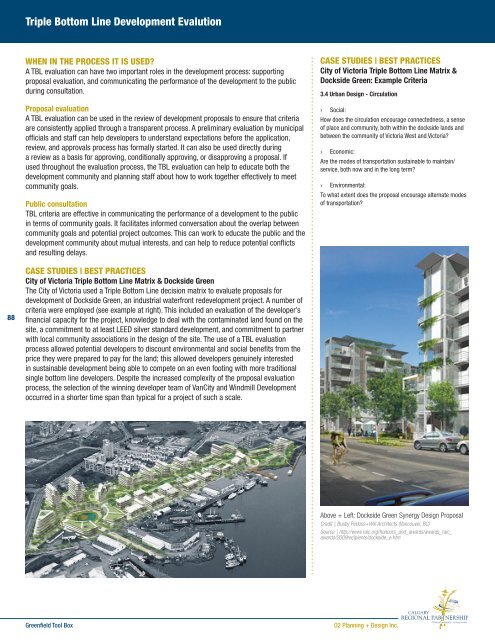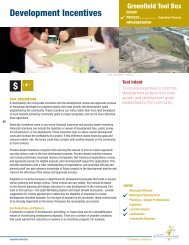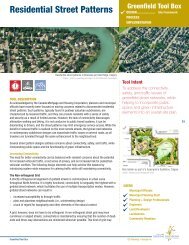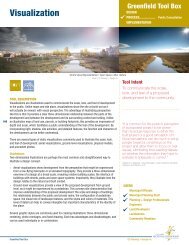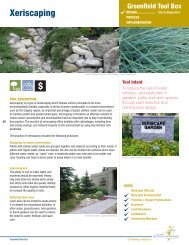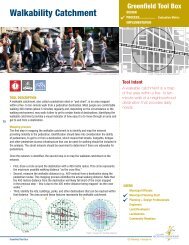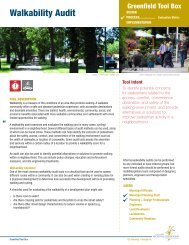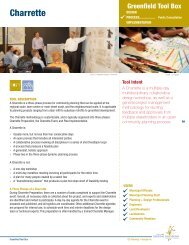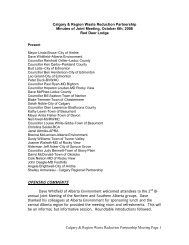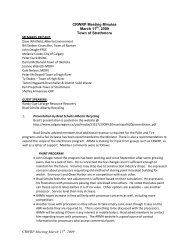Triple Bottom Line Development Evaluation - The Greenfield Tool Box
Triple Bottom Line Development Evaluation - The Greenfield Tool Box
Triple Bottom Line Development Evaluation - The Greenfield Tool Box
You also want an ePaper? Increase the reach of your titles
YUMPU automatically turns print PDFs into web optimized ePapers that Google loves.
<strong>Triple</strong> <strong>Bottom</strong> <strong>Line</strong> <strong>Development</strong> EvalutionWHEN IN THE PROCESS IT IS USED?A TBL evaluation can have two important roles in the development process: supportingproposal evaluation, and communicating the performance of the development to the publicduring consultation.Proposal evaluationA TBL evaluation can be used in the review of development proposals to ensure that criteriaare consistently applied through a transparent process. A preliminary evaluation by municipalofficials and staff can help developers to understand expectations before the application,review, and approvals process has formally started. It can also be used directly duringa review as a basis for approving, conditionally approving, or disapproving a proposal. Ifused throughout the evaluation process, the TBL evaluation can help to educate both thedevelopment community and planning staff about how to work together effectively to meetcommunity goals.Public consultationTBL criteria are effective in communicating the performance of a development to the publicin terms of community goals. It facilitates informed conversation about the overlap betweencommunity goals and potential project outcomes. This can work to educate the public and thedevelopment community about mutual interests, and can help to reduce potential conflictsand resulting delays.CASE STUDIES | BEST PRACTICESCity of Victoria <strong>Triple</strong> <strong>Bottom</strong> <strong>Line</strong> Matrix &Dockside Green: Example Criteria3.4 Urban Design - Circulation› Social:How does the circulation encourage connectedness, a senseof place and community, both within the dockside lands andbetween the community of Victoria West and Victoria?› Economic:Are the modes of transportation sustainable to maintain/service, both now and in the long term?› Environmental:To what extent does the proposal encourage alternate modesof transportation?88CASE STUDIES | BEST PRACTICESCity of Victoria <strong>Triple</strong> <strong>Bottom</strong> <strong>Line</strong> Matrix & Dockside Green<strong>The</strong> City of Victoria used a <strong>Triple</strong> <strong>Bottom</strong> <strong>Line</strong> decision matrix to evaluate proposals fordevelopment of Dockside Green, an industrial waterfront redevelopment project. A number ofcriteria were employed (see example at right). This included an evaluation of the developer’sfinancial capacity for the project, knowledge to deal with the contaminated land found on thesite, a commitment to at least LEED silver standard development, and commitment to partnerwith local community associations in the design of the site. <strong>The</strong> use of a TBL evaluationprocess allowed potential developers to discount environmental and social benefits from theprice they were prepared to pay for the land; this allowed developers genuinely interestedin sustainable development being able to compete on an even footing with more traditionalsingle bottom line developers. Despite the increased complexity of the proposal evaluationprocess, the selection of the winning developer team of VanCity and Windmill <strong>Development</strong>occurred in a shorter time span than typical for a project of such a scale.Above + Left: Dockside Green Synergy Design ProposalCredit | Busby Perkins+Will Architects (Vancouver, BC)Source | http://www.raic.org/honours_and_awards/awards_raic_awards/2009recipients/dockside_e.htm<strong>Greenfield</strong> <strong>Tool</strong> <strong>Box</strong>O2 Planning + Design Inc.


